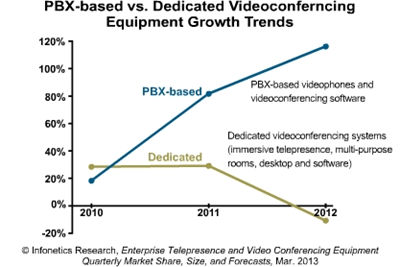2013年3月14日、マサチューセッツ州ボストン-市場調査会社のInfonetics Researchは、第4四半期(4Q12)及び年末のEnterprise Telepresence and Video Conferencing Equipmentレポートから抜粋を発表した。本レポートでは、専用及びPBXベースのビデオ会議設備、テレプレゼンス設備、エンドポイント機器(デスクトップPC、イマーシブ・テレプレゼンス、テレビ電話、多目的ルーム、ソフトウェア)について追跡調査している。

アナリストノート
「ビデオ会議市場は、2012年前半に振るわない結果を残しましたが峠を越しつつあるようです。前四半期に2ケタ成長を記録したのに続き、第4四半期もまた収入が増加し、年間の収入を差し引きで横ばいに維持しました」
Infonetics Researchで企業向けネットワーク及びビデオ担当のディレクティングアナリストを務めるMatthias Machowinskiは、このように説明する。
「市場を上向きに支えているのは、PBXベースのビデオエンドポイント機器による売上で、2012年は倍以上の伸びを示しました。PBXベースのビデオ機器には人気が集まっています。なぜなら、既存設備を利用してマルチメディアコミュニケーションが実現できる、コスト効率の良い方法だからです」
Machowinski は更に付け加える。
「2012年は例外的な年だったと考えています。企業は、ビデオコミュニケーション機器の導入に長期的な関心を注いでいる様子ですので、市場が2017年までの年平均成長率を6%に維持する助けとなるでしょう」
テレプレゼンス及びビデオ会議市場のハイライト
- 企業向けビデオ会議及びテレプレゼンス機器による全世界の収入は、4Q12に前期比10%増を記録し、8億2200万ドルとなった。
- 2012年は、PBXベースのビデオ機器が成長したことで、エンドポイント機器の出荷数が47%増加した。
- ビデオ会議専用システムのほぼ全てが、2012年に収入を落とした。中には大きく低下したセグメントもあり、マルチポイントコントロールユニット(MCU)のみが横ばいとなった。
- アジア太平洋は、2012年に収入がプラス成長を記録した唯一の地域で、前年比11%増であった。
- CiscoとPolycomは、引き続きビデオ会議専用機器市場のリードを握っている。
- 浮き沈みの激しかった過去2年間の結果を受けて、イマーシブ・テレプレゼンスのセグメントは回復に向かうとInfoneticsは予測している。
- 今後、企業向けビデオ機器の成長を促していく要素には次のようなものがある。技術進歩とその普及(例、高解像度ビデオ、回線容量)、人口動態およびコミュニケーションのトレンド、遠隔講義や遠隔医療などへの具体的な活用。
Infonetics' quarterly video conferencing report provides worldwide and regional market size, vendor market share, forecasts through 2017, analysis, and trends for dedicated enterprise video equipment, including infrastructure (MCUs, other) and endpoints (desktop, immersive telepresence, multipurpose room, and software-based), and PBX-based videophones and software-based video conferencing clients. Vendors tracked: Avaya (Radvision), Cisco, Huawei, Logitech (LifeSize), Polycom, and others.
(原文)
Video conferencing market gearing up for comeback
Boston, MASSACHUSETTS, March 14, 2013-Market research firm Infonetics Research released excerpts from its 4th quarter (4Q12) and year-end Enterprise Telepresence and Video Conferencing Equipment report, which tracks dedicated and PBX-based video conferencing and telepresence infrastructure and endpoints (desktop, immersive telepresence, videophones, multipurpose rooms, and software).
ANALYST NOTE
"After a rotten early 2012, the video conferencing market appears to be turning the corner. On the heels of double-digit growth the previous quarter, revenue was up again in the 4th quarter, keeping full year revenue essentially flat," reports Matthias Machowinski, directing analyst for enterprise networks and video at Infonetics Research. "Helping the market stay afloat were sales of PBX-based video endpoints, which more than doubled in 2012. PBX-based video is proving popular because it offers organizations a cost-effective way to enjoy multimedia communication using infrastructure they already have."
Machowinski adds, "We view 2012 as an aberration, and see long-term interest by enterprises to deploy video communications, helping the market to sustain a 6% CAGR through 2017."
TELEPRESENCE AND VIDEO CONFERENCING MARKET HIGHLIGHTS
- Globally, enterprise video conferencing and telepresence revenue grew 10% sequentially in 4Q12, to $822 million
- In 2012, endpoint shipments rose 47%, driven by the growth of PBX-based video
- Revenue for nearly all dedicated videoconferencing systems declined in 2012, with some segments falling off significantly; only multipoint control units (MCUs) held steady
- Asia Pacific was the only region to notch positive revenue growth in 2012, up 11% over 2011
- Cisco and Polycom continue to lead the dedicated videoconferencing equipment market
- On a rollercoaster ride for the past 2 years, Infonetics expects the immersive telepresence segment to bounce back
- Factors driving the future growth of enterprise video include advances in and proliferation of technology (e.g., high-definition video, bandwidth); demographic and communication trends; and specific use cases such as telelearning and telemedicine

